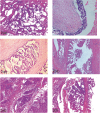lnvasive cystic hypersecretory carcinoma of the breast associated with papillary pattern: a rare and poorly recognised variant of ductal carcinoma of the breast
- PMID: 25435905
- PMCID: PMC4239127
- DOI: 10.3332/ecancer.2014.477
lnvasive cystic hypersecretory carcinoma of the breast associated with papillary pattern: a rare and poorly recognised variant of ductal carcinoma of the breast
Abstract
Cystic hypersecretory pattern is a rare and poorly recognised variant of invasive ductal carcinoma of the breast. Cystic hypersecretory lesions of the breast have a spectrum of morphological features ranging from clearly benign cystic hypersecretory hyperplasia (CHH), CHH with atypia, cystic hypersecretory carcinoma (CHC) to invasive CHC. Until now, no case of invasive CHC has been reported in India, to the best of our knowledge. We report a case of a 57-year-old female with a history of a lump in the inferomedial quadrant of the right breast for three years, gradually increasing in size. A mammography showed a well-defined, lobulated radio-opacity. A modified radical mastectomy was done. Gross examination showed multiple cystic spaces filled with thick gelatinous material and solid areas. On histopathology, cystic hypersecretory variant of invasive ductal breast carcinoma with focal papillary pattern was diagnosed. Cystic hypersecretory ductal carcinoma behaves in a low-grade fashion for many years but has a potential for invasiveness and metastasis, so regular follow-up of such cases is crucial.
Keywords: breast; carcinoma; mastectomy.
Figures


References
-
- Erdinç Kamer, et al. Invasive cystic hypersecretory ductal carcinoma of the breast. Meme Sağlığı Dergisi. 2008. Cilt 4 Sayı 2.
-
- Skálová A, et al. Cystic hypersecretory carcinoma: rare and potentially aggressive variant of intraductal carcinoma of the breast. [Report of five cases] CeskaGynekol. 2005;70(1):73–8. - PubMed
-
- Paul Peter Rosen. Rosen’s breast pathology chapter cystic hypersecretory carcinoma and cystic hypersecretory hyperplasia. 2009:581–589.
-
- Guerry P, Erlandson RA, Rosen PP. Cystic hypersecretory hyperplasia and cystic hypersecretory duct carcinoma of the breast Cancer. 1988;61(8):1611–1620. - PubMed
Publication types
LinkOut - more resources
Full Text Sources
Other Literature Sources
